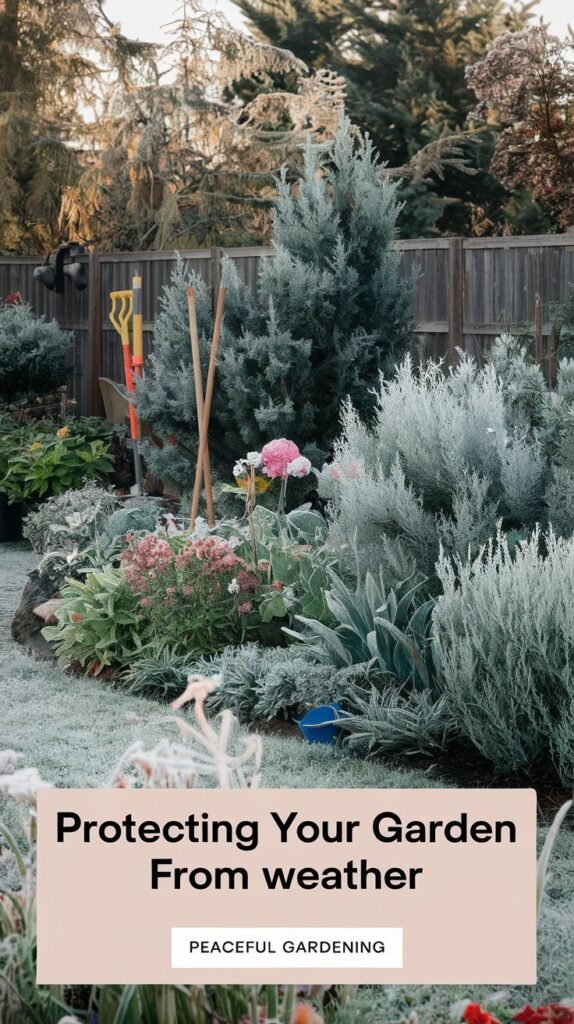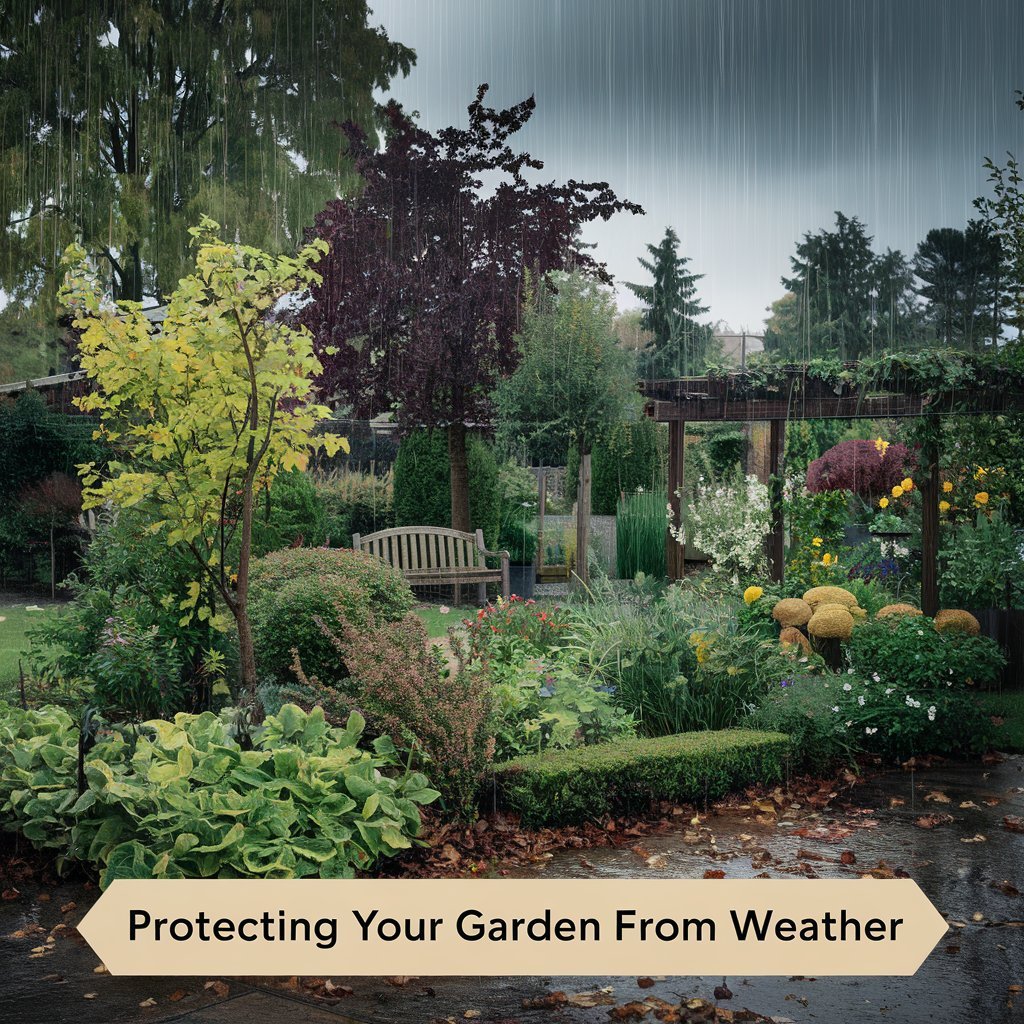Key Takeaways
- Significance of safeguarding your garden from the elements
- Approaches to shield your garden
- Seasonal methods for fortifying against weather
- Equipment and supplies for weather defense
Importance of Protecting Your Garden from Weather
Weather can dramatically affect the health and appearance of any garden. Protecting your garden from weather extremes ensures that your garden plants thrive rather than suffer. Gardens designed with resilience in mind, including features like water gardens and container gardens, can flourish even amidst challenging conditions. Gardeners should consider how elements like hedges and shrubs can offer shade or windbreaks, providing essential protection. A well-planned yard will not only enhance landscaping but also safeguard against unexpected weather events. By understanding the importance of protecting your garden from weather, individuals can maintain vibrant, healthy gardens year-round.

Effects of Extreme Weather on Garden Health
Extreme weather can severely impact the vitality of plants in any garden. Unexpected cold snaps can harm tender shrubs and young seedlings, while intense heat can cause foliage to scorch and lawns to wither. Gardeners need to be vigilant, ensuring that their planting strategies incorporate resilient species that can withstand temperature fluctuations. Without proper protection, potted plants and air plants may struggle to survive harsh conditions, leading to a decline in overall garden health.
Heavy rain and wind can also create challenges for protecting your garden from weather. Soil erosion can wash away vital nutrients while flooding can drown roots, particularly in areas with poor drainage. Shrubs and bushes are often damaged by high winds, resulting in broken branches and dislodged plants. Implementing weather protection methods like greenhouses and protective covers can help maintain the integrity of the landscape, allowing plants to thrive despite the adverse conditions. Without these precautions, weeds may take over, further complicating the gardener’s efforts.
Benefits of Weather Protection for Plants
Extreme weather can significantly impact the health of your vegetation. Protecting your garden from weather not only preserves the aesthetic appeal but also ensures the vitality of crops, herbaceous perennials, and leafy greens. Implementing structures like greenhouses or patio covers can provide essential shelter from harsh climates, minimizing loss to drought. This protection helps maintain moisture in the soil, crucial for the overall health and growth of evergreen plants and flowers like blanket flower.
Another important benefit of weather protection is the enhancement of plant resilience. By safeguarding your garden, you create a more stable environment for plants to thrive. This is particularly beneficial for drought-tolerant species that may struggle without sufficient soil moisture. Using effective strategies can reduce the need for excessive watering, allowing gardeners to focus on nurturing growth while ensuring that their gardens are well-equipped to handle seasonal changes. Protecting your garden from weather allows for thriving ecosystems that support diverse plant life.
Strategies to Protect Your Garden
Protecting your garden from weather extremes is essential for maintaining the health of annual plants and flowering plants. Different weather systems can pose various challenges that threaten soil life, especially in a backyard garden patch. Strategies such as utilizing structures for shelter or selecting resilient plant varieties can make a significant difference in how well your garden survives harsh conditions. For instance, during periods of compacted soil or when facing intense garden heat, implementing effective protection measures will ensure your plants thrive. Proper planning allows your garden to withstand adverse elements while taking advantage of mild gardening weather, ultimately enhancing the beauty and vitality of your landscapes.
Utilizing Structures for Shelter
Setting up structures around your outdoor plants can significantly enhance their ability to withstand harsh weather conditions. Garden tips often suggest using garden fleece or blankets to provide extra insulation for in-ground gardens during temperature fluctuations. These protective layers can be crucial for warm weather crops and other budding garden varieties, ensuring that they thrive despite the unpredictable elements. Strategic garden placement is essential, as positioning plants near wind barriers can further shield them from damaging winds, making a noticeable difference in their health.
Using physical structures not only helps protect plants but also creates a microclimate that fosters growth. For salt-tolerant garden plants, this approach can be particularly beneficial, allowing them to flourish even in less than ideal weather. Incorporating garden blankets helps retain moisture and warmth, promoting better root development. Adequate shelter, such as trellises or row covers, can effectively safeguard outdoor plants while enhancing their resilience against the challenges of nature. Protecting Your Garden from Weather becomes an easier task with these thoughtful structures in place.
| Structure Type | Purpose | Benefits |
|---|---|---|
| Garden Fleece/Blanket | Insulation for plants | Retains warmth & moisture; protects against frost |
| Trellises | Support for climbing plants | Maximizes space; enhances sunlight exposure |
| Row Covers | Protection from pests and harsh weather | Maintains temperature; prevents frost damage |
| Wind Barriers (e.g., hedges) | Shield plants from strong winds | Reduces wind stress; promotes healthier plants |
| Cold Frames | Extend the growing season | Protects seedlings; promotes early germination |
Choosing the Right Plants for Resilience
Selecting the right plants is crucial for protecting your garden from weather extremes. Resilient varieties not only thrive in challenging conditions but also play a vital role in enhancing the overall health of your garden soil. Many common garden veggies, like kale and carrots, exhibit robust growth even in less than ideal climates. By choosing covered plants that can withstand heavy rain or dry spells, backyard gardeners can create resilient vegetable gardens that require less intervention. Smart gardening techniques, such as planting root crops that are naturally more resilient, contribute to a thriving garden even amid unpredictable weather.
Understanding plant resilience also involves strategic planning and consideration of local conditions. Gardeners often benefit from incorporating a mix of hardy perennials and annuals, ensuring a more stable ecosystem. Plant covers can provide added protection for fragile garden sections during severe weather. Additionally, garden fences and windbreaks can shield vulnerable plants from harsh winds, promoting a healthier growing environment. This approach not only enhances the resilience of your plants but also contributes to a more sustainable gardening practice.
Seasonal WeatherProofing Techniques
Protecting your garden from weather extremes requires careful planning throughout each season. In spring, home gardeners should prepare for rain and wind by reinforcing structures and covering tender plants to shield delicate foliage. Summer brings the challenge of heat and drought, making it essential to choose drought-tolerant plants and ensure low plantings are adequately hydrated. During fall, protecting your garden from frost and chill involves mounding up mulch around the trunks and roots of outdoor plants, which helps insulate vulnerable plants.
For gardeners in southern gardens, such as where I live, in Texas, planting cool-season crops can thrive despite fluctuating temperatures. In winter, tall hedges can provide a windbreak, while covering nearby plantings helps protect them from the harsh elements. By utilizing these strategies, gardeners can maintain healthy foliage beneath protective measures available at garden stores.

Spring: Preparing for Rain and Wind
Spring brings the challenge of managing increased rainfall and gusty winds. Protecting Your Garden from Weather during this season requires careful planning. Begin by replacing landscape plastic with mulch in garden beds to help absorb moisture and prevent waterlogged lawns. It is crucial to strategically place plants to shield vulnerable areas. Cool-season crops thrive during this time. Individual plants with dense foliage can also offer protection to neighboring crops, creating a healthier garden environment.
To combat strong winds, consider utilizing structures like trellises or stakes to support larger plants. These supports will help garden handle mother nature’s whims. Special garden cloth can provide an additional layer of protection for newly planted areas. Ensure that plants are well-anchored in their spots to withstand shifting conditions. As you prepare your garden for rain and wind, remember that proper placement and support can make all the difference in fostering a thriving garden.
Summer: Shielding Against Heat and Drought
Heat and drought can pose significant challenges for your garden during the summer months. Protecting your garden from weather extremes requires proactive measures. Creating temporary shade for precious plants can help mitigate the effects of intense sun. Using metal garden beds allows for better drainage and temperature regulation, benefiting plant health. It’s also wise to monitor recommended planting dates to ensure you select crops that can thrive in the heat. Watering plants early in the day or late in the evening conserves moisture and minimizes evaporation, especially for shallow-rooted and sensitive crops.
Preventing moisture loss is essential for maintaining green landscapes throughout the summer. Mulching the exposed soil can reduce evaporation and keep plant roots cool. Portable greenhouses are excellent for protecting vulnerable plantings from harsh sunlight while allowing for air circulation. Proper irrigation techniques, such as drip systems, can deliver water directly to the roots, ensuring efficient water use. Protecting your garden from weather extremes not only preserves your hard work but also enhances the overall vitality and resilience of your garden.
Fall: Safeguarding from Frost and Chill
As the temperatures dip in the fall, protecting your garden from weather-related challenges becomes essential. Frost can quickly damage cherished plants and new plantings, especially many delicate plants and warm-season crops—like tomatoes. To preserve soil temperature and ensure healthy growth, consider covering tender plants with commercial frost cloths or row covers. This simple measure can greatly enhance the resilience of your garden during chilly nights.
Planning for frost involves more than just protective coverings. Good soil plays a crucial role in helping many plants survive the cold months. Tall plants and tree-dwelling plants can offer valuable windbreaks, while small plants nestled among planters benefit from insulation provided by larger foliage. A little preparation goes a long way in safeguarding your garden and ensuring that your crops—like pumpkins and squash—thrive even as the fall air turns crisp.
Winter: Insulating Plants from Snow and Ice
During winter, protecting your garden from weather extremes becomes crucial, especially for tender plants that are susceptible to freezing temperatures. Insulating techniques can involve mulching around your plants to maintain soil temperatures and prevent plant damage. Utilizing small greenhouses can also act as a garden miracle-worker, keeping contained plants safe while ensuring the soil remains moist. This method helps sustain good harvests by minimizing the risk of damage from frost and ice.
Dry soil can lead to increased susceptibility to winter stress. Ensuring that your garden beds have well-draining soil is vital for maintaining healthy root systems. Incorporating drought-resistant flowering plants can bolster your garden’s resilience against winter hardships. As a certified master gardener knows, a proactive approach in winter not only saves your plants from damages but also sets the stage for a thriving garden come spring.
Tools and Materials for Weather Protection
To effectively implement strategies for protecting your garden from weather, utilizing the right tools and materials is essential. Creating a shaded area using tropical plant materials can provide shade relief for heat-tender plants during the sweltering summer months. Employing protective covers and tarps can help shield dormant plants from harsh winter conditions while retaining beneficial soil life.
An automatic plant waterer proves invaluable during dry weather, ensuring that different crops receive consistent watering. For hardy plants, using garden twine can help support growth while keeping soil close to the roots, which is vital for the overall health of your garden in varying local climates. These tools contribute significantly to maintaining a thriving garden throughout the seasons.
Protective Covers and Tarps
Protecting your garden from weather extremes can be effectively achieved through the use of protective covers and tarps. These materials shield young plants from harsh winds, helping them avoid wind-whipped leaves that can stunt growth. Well-watered ones, such as hibiscus plants and other tender crops, benefit greatly from a protective layer, especially in warmer climates where excess sunlight can dehydrate thirsty plants. Tarps can also assist in creating sheltered areas for vertical plantings, minimizing the impact of inclement weather on your garden’s overall health.

Utilizing protective covers gives gardeners an edge in battling weeds and protecting soil thoroughly. Many container plants thrive under the security of tarps during seasonal transitions, as these coverings help maintain optimal soil temperature. For those looking to ensure their plants survive outdoor winters, using tarps allows the retention of warmth while shielding delicate root systems from frost. With the right materials in place, protecting your garden from weather becomes a manageable task, leading to healthier and more resilient plants throughout the seasons.
Fencing and Windbreaks
Creating a sheltered area around your garden can significantly aid in protecting your plants from harsh weather conditions. Fencing and windbreaks can help shield vegetable crops from strong winds, which often lead to dry soils and poor soil drainage. These barriers are particularly beneficial in maintaining moisture levels, ensuring that soils remain moist and healthy. With the right setup, container plants can also thrive, as the protection offered by fencing reduces the risk of lost crops due to unpredictable weather patterns. Utilizing plant tags can help you monitor the health and adaptability of your crops throughout varying conditions.
Implementation of fencing and windbreaks serves not only as a protective measure but also as a strategy for maintaining optimal growing conditions. Chopped leaves or plastic can be used in conjunction with these structures to suppress weeds and retain soil moisture. This combination helps avoid the common pitfalls associated with frost-free weather, particularly for sensitive plants. A dedicated approach to protecting your garden from weather extremes can lead to flourishing growth during all seasons. Investing time and resources into this aspect of gardening is key to thriving plants and bountiful harvests, ultimately enhancing the resilience of your garden ecosystem.
- Design your fence or windbreak with materials that blend with the natural landscape.
- Consider using native plants for your windbreak, as they’ll require less maintenance.
- Ensure there’s a proper gap between the fence and your crops to allow for airflow.
- Regularly check and maintain your fencing to prevent any structural damage.
- Use wind-resistant plants to create a natural barrier alongside or instead of fencing.
- Position your windbreak strategically to block the prevailing winds.
- Monitor moisture levels regularly to assess the effectiveness of your windbreak setup.
Conclusion
Protecting your garden from weather extremes is essential for maintaining a healthy and vibrant landscape. Utilizing protective covers like shade cloth not only shields plants from harsh sunlight but also helps in managing temperatures during great weather fluctuations. For those looking to safeguard their more delicate varieties, planting indoors or opting for container plants indoors provides an effective strategy to avoid potential damage from extreme conditions. By implementing these practices, gardeners can ensure their plants thrive regardless of the season, demonstrating the importance of proactive measures in protecting your garden from weather challenges.
FAQS
How can I protect my garden during extreme weather conditions to ensure my outside plants thrive?
To protect your garden, especially your outside plants, you can set up wind barriers around your garden beds to shield them from strong gusts. Additionally, consider covering tender plants with commercial frost cloths or row cover during cold snaps. Using mulch in your garden beds not only suppresses weeds but also helps retain moisture in the soil, which is vital for keeping the soil moist during drought periods.
For root crops, you can mound up mulch around the trunks and roots of outdoor plants to add extra insulation. Furthermore, plant cool-season crops that are more tolerant to temperature changes. If conditions become severe, moving large plants into a greenhouse can provide an extra layer of protection. Remember that keeping your soils moist is key for the health of your plants, so don’t forget to water plants adequately as needed.
What are some effective strategies to enhance your garden designed for protection against various weather elements, including frost and drought?
To protect your garden designed for diverse weather elements, consider implementing several strategies. First, cover tender plants with commercial frost cloths or row covers to shield them from frost damage. Additionally, mulch in garden beds will help replace landscape plastic, retaining moisture in moist soil and providing extra insulation for root crops. For areas prone to drought, focus on selecting drought resistance flowering plants. Moreover, pressing gardening experts advise to water—especially shallow-rooted plants—during dry spells. If conditions worsen, you might even plant indoors to ensure a steady growth environment, while also installing a local garden pond to help manage moisture levels throughout your plant areas.
What are some effective ways gardeners can protect root crops from damages caused by varying weather conditions, including using potting soil and extra insulation in gardens?
To protect root crops from potential damages caused by extreme weather, gardeners can utilize potting soil to improve soil structure and moisture retention. Additionally, adding extra insulation in gardens can help buffer against temperature fluctuations. Gardeners may also replace landscape plastic with mulch in garden beds, as mulch helps suppress weeds and retains soil moisture. These strategies might assist in maintaining a stable environment for plants—and ultimately, help them thrive in a greenhouse cool setting, regardless of changing weather patterns.
What methods can garden enthusiasts use to make gardens more resilient against damages caused by harsh weather elements?
To make gardens more resilient against damages plants may experience from harsh weather, gardening experts suggest several methods. One way gardeners can enhance their gardens is to replace landscape plastic with mulch in garden beds, as plastic suppresses weeds while mulch also provides extra insulation garden. It’s beneficial to apply extra insulation during strong weather events to protect sensitive plants. Additionally, be mindful of watering—they may need to adjust their watering routines to better support plant survival in varying conditions. Lastly, soil perking and regularly reading landscape weather sites can help anticipate what challenges lie ahead.
What are some recommendations from a gardening expert on how to replace landscape plastic with mulch in garden beds to battle weeds?
A gardening expert suggests that you should replace landscape plastic with mulch in garden beds as it can significantly help in battling weeds. Mulch retains moisture and regulates soil temperature, which benefits your plants. It’s important to plant it properly; make sure to press down the mulch gently to keep it in place, as poorly applied mulch can wash away during heavy rain. For various weather conditions, many weather sites recommend using organic mulch options, as they can improve soil health and support your plants’ growth. If you choose to plant otherwise, be mindful of how mulch interacts with the overall climate in your garden.
How can I replace landscape plastic with mulch in garden beds to battle weeds effectively according to a gardening expert?
To effectively replace landscape plastic with mulch in garden beds and battle weeds, it is essential to first prepare the area by removing existing plastic and any weeds present. Then, a layer of organic mulch can be applied to suppress future weed growth. Gardening experts often recommend using a thick enough layer of mulch—typically 2 to 3 inches—to prevent light from reaching weed seeds. This method not only battles weeds but also helps retain moisture and improve soil quality as the mulch decomposes. Make sure to read landscape design guidelines to select the best mulch type for your garden needs.
How can I improve my garden’s resilience to weather effects, and is it beneficial to replace landscape plastic with mulch in garden beds as suggested by a gardening expert?
To enhance your garden’s resilience against weather effects, it is indeed beneficial to replace landscape plastic with mulch in garden beds, as highlighted by a gardening expert. This practice allows your plants to thrive and protects them from extreme conditions while also suppressing weeds and improving soil moisture retention.
What are the advantages of replacing landscape plastic with mulch in garden beds according to a gardening expert?
According to a gardening expert, when you replace landscape plastic with mulch in garden beds, it can significantly enhance the health of your plants. Mulch helps retain moisture, suppress weeds, and improve soil quality, allowing your plant—it to thrive better in various conditions. This natural alternative is often preferred over plastic as it provides additional benefits like insulation for the soil and support for beneficial microorganisms.
What are the best practices to replace landscape plastic with mulch in garden beds as recommended by a gardening expert?
According to a gardening expert, to effectively replace landscape plastic with mulch in garden beds, it’s important to first remove any existing plastic, then prepare the soil by loosening it and adding compost. Next, choose the right type of mulch, such as wood chips or straw, and apply a layer that is at least 2-3 inches thick to suppress weeds, retain moisture, and improve soil health. This method not only provides a more eco-friendly option but also enhances the overall appearance of your garden.
What steps should I take to effectively replace landscape plastic with mulch in garden beds while ensuring the advice of a gardening expert is considered?
To effectively replace landscape plastic with mulch in garden beds, it is recommended to first remove the existing plastic, then prepare the soil by weeding and leveling it. After that, apply a layer of mulch as suggested by a press gardening expert, which will help suppress weeds while also improving the health of the soil and plants.

My name is Michelle Warren, and I’m the founder of Peaceful Gardening. As a 10-year breast cancer survivor, I’ve discovered the profound therapeutic power of gardening. This journey has not only helped me recover but has also become my passion and a source of ongoing peace and joy.
Peaceful Gardening was born from my desire to share the healing benefits of gardening with others. Whether you’re facing health challenges, dealing with stress, or simply looking to connect more deeply with nature, this space is for you.
Over the past decade, I’ve cultivated not just plants, but a deep understanding of how gardening can positively impact mental health. I’ve worked with local community gardens, led workshops on mindful gardening practices, and collaborated with mental health professionals to develop gardening-based stress reduction programs.
Peaceful Gardening was born from my desire to share the healing benefits of gardening with others. Whether you’re facing health challenges, dealing with stress, or simply looking to connect more deeply with nature, this space is for you.
Here, you’ll find evidence-based advice on using gardening as a tool for mindfulness, stress relief, and emotional healing. I share personal stories, practical tips, and scientifically-backed information on how to create your own therapeutic garden space, no matter the size of your yard or balcony.
My mission is to help you discover the joy, peace, and healing that comes from nurturing plants and connecting with nature. Join me in exploring how the simple act of tending to a garden can transform your mental and emotional wellbeing.
Welcome to Peaceful Gardening – let’s grow together towards better mental health!”

